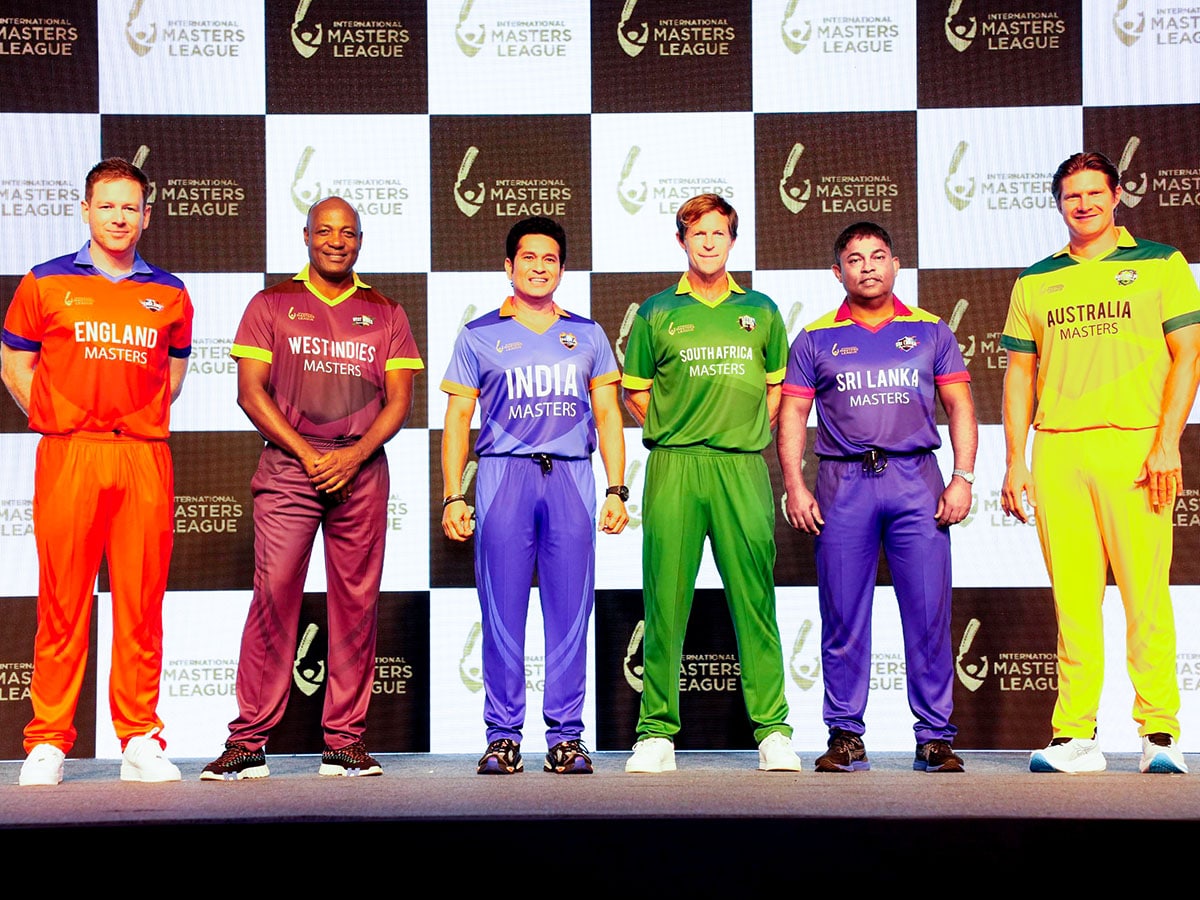There Will Always Be Market For Premium Cricket Content: Venu Nair – Forbes India

(From left) Eoin Morgan, Brian Lara, Sachin Tendulkar, Jonty Rhodes, Romesh Kaluwitharana, Shane Watson, former international cricket stars from England, West Indies, India, South Africa, Sri Lanka and Australia, respectively, at the launch event of the International Masters League.
Image: Courtesy IML
In November, cricket will board a time machine as a stellar cast—comprising the likes of yesteryear legends Sachin Tendulkar, Brian Lara, Jacques Kallis, Kumar Sangakkara—will take to the field for a T20 franchise league. Christened the International Masters League (IML), the six-team tournament is the brainchild of Sunil Gavaskar and Tendulkar, and is being organised in collaboration with global sports marketing agency Sportfive. The first four matches will take place at Mumbai’s DY Patil Stadium beginning November 17, after which the tournament will hop to Lucknow before reaching Raipur for the final set of matches.
“Passion and love for the game,” said Tendulkar, the captain of the India Masters and the IML brand ambassador when asked about the trigger for the league, during its recent launch event in Mumbai, while Eoin Morgan, England’s World Cup-winning captain and the skipper of the England Masters, underlined that the calibre of players in the league will set it apart.
In an exclusive conversation with Forbes India, Venu Nair, president-global cricket of Sportfive, echoed Morgan’s sentiments when he said there is always an uptake for premium cricket content, and with names like Tendulkar, Lara, Kallis, Sangakkara etc involved, he’s confident the IML will stand out in a crowded sports leagues market. Edited excerpts from the conversation:
Q. What was the rationale behind launching the IML?
One, because you will see that there is a mushrooming of various forms of what is sometimes referred to as exhibition cricket, or league cricket or franchise cricket et al. What it tells you is that, in the market, there is a need and a demand for watching cricketers who have retired to perform again on a competitive level.
When it comes to the genesis of the idea of the IML, I completely credit Tendulkar for it—he started talking to me about this about a couple of years ago, saying he feels there are so many underserved markets across India and the globe when it comes to international cricket because only a finite amount of the sport is played. There are markets and brands that would want to be associated with players of that calibre as long as they are seen to be performing on the field.
About a year ago, Mr [Sunil] Gavaskar and his senior management team at PMG approached us and started shooting ideas about what can we do in the world of cricket. PMG handles a lot of brands, and we work with a lot of brands globally. The combination of all these factors, and the ability to figure out that there are certain brands, both within India and globally, who are looking to invest in cricket is how the IML came about.
It has been a journey for over a year, we understand the pitfalls of it and are working through them, and I believe that, at least in the first season, we would be able to plug 90 to 95 percent of those.
 Venu Nair, president-global cricket of Sportfive
Venu Nair, president-global cricket of Sportfive
Q. In India right now, there are close to 20 sports leagues, and many of them in cricket. Can IML stand out in this crowded space?
I don’t claim to know every league that is operating out there, but I can confidently say that our research shows some key factors. One, I don’t think anybody does a proper job of a nation versus nation tournament on the level that we plan to. One of the underpinned rules of our league, which is set in stone largely by the governing council—made up of Gavaskar as the commissioner, and Vivian Richards, Simon Taufel and Shaun Pollock—is that if you want to be part of this you have to have represented your country internationally. I can challenge you that you will not find that in any such product anywhere in the world.
And credit goes to Melroy [D’Souza, COO, PMG] for having put in the hard yard of going into the market, researching where the holes are and how we will fill it. Probably a lot of people haven’t quite grasped the fact that we don’t intend to stop after two or three seasons. As Lara said on the stage during the launch event, he may be at the back-end of the spectrum [being among the oldest of the icons], but he will, over time, be replaced by somebody else who’s coming off the bench.
In international cricket, with the proliferation of better coaching and training facilities, players are increasingly reaching the end of their career faster not because they’re unfit or can’t play but because the guys on the bench are pushing them off. Due to that, there is a large cross-section of people who are willing to play serious cricket even after they retire. PMG, Gavaskar, Tendulkar and us hope that we will provide them that serious infrastructure for years to come. That’s a unique window that we have.
Q. You are going to play the inaugural season in three cities in India, two of them non-metros. How do you plan to capture global attention?
Quality cricket can be played anywhere and if it’s on TV, it can be watched from anywhere. You’re playing cricket in New York, not a city where cricket is played, during a T20 World Cup. Cricket has become such a global game that the geographical location of where it is being played is irrelevant. As long as you are able to produce content and the action on the ground is at the highest level, it will be consumed as a premium content anywhere in the world. So, tomorrow, when we put out our feed with the best broadcast technology available and you watch it on a premium broadcaster in the US, or somebody even mentioned Tokyo to me, that’s a global audience.
Q. As multiple leagues vie for a finite share of the sponsorship money, how are you planning to make IML a lucrative proposition for brands?
There may be multiple versions of multiple sporting events happening in the world. There used to be an argument before that how many more leagues can one have? But if you take an example of football, concurrently there will be at least 65 leagues going around in the world. Each country has its own ecosystem, its own economy, its own brands, and its own ability to monetise it. As long as there are professionals who do their job at the highest level and we are able to show it’s a best-in-class tournament, the best-in-class brands will always want to get associated with us. In the one week we’ve announced the launch of the IML, calls from brands—to say that we don’t usually associate with other leagues but we want to know what this is—haven’t stopped coming. Which tells us maybe the leagues around the world are not delivering to the level the brands want in terms of an ROI on their investment.
Q. How can the audience for cricket expand just beyond the top cricket-playing nations?
I have never understood this argument about increasing the number of people watching cricket. Do you see the Americans saying that I want to take baseball to Germany? They may play some exhibitions, but not otherwise. We have to understand that cricket is a unique sport, just like rugby or a few other sports, which has a unique catchment area where, culturally, people understand the sport better than others. Cricket in India grows and people of Indian, South Asian or even Commonwealth origin, who have the DNA of the sport within them, will always keep it growing.
Maybe other people will also pick it up—I’m not saying they won’t, like there are teams out of Europe, like the Netherlands or Ireland. But that requires a lot more investment by the ICC to get cricket into schools. We are not claiming to take cricket into schools.
There is a whole lot of people who are passionate about cricket and have said stories about players like Tendulkar to their children. But they have never been able to visualise it for them. We are giving them the ability to show those kids for real what they’ve always heard in words. Through IML, today’s generation can actually see a Tendulkar playing. And as long as I can capture that market and get to that audience around the world, we’re fine here.
Related
‘Not ideal’: South Africa’s David Miller on travel to and…
South Africa's David Miller cradles his bat after scoring a century during the Champions Trophy semi-final against New Zealand at Gaddafi Stadium in Lahore. (A
Virat Kohli ‘knew’ about Steve Smith’s retirement? Touching Champions Trophy…
Crickets fans, on Wednesday, found out the exact moment Steve Smith revealed his retirement from ODI cricket as fresh footage from his interaction with India
Sachin Tendulkar plays ‘lone warrior’ in age-defying masterclass, hammers 64…
Mar 06, 2025 06:15 AM IST Sachin Tendulkar produced a vintage knock during India Masters' clash against Australia Masters, smashing 64 off just 33 b
‘Aaqib Javed is a clown’: Jason Gillespie opens can of…
Former Australia fast bowler Jason Gillespie, who abruptly quit as Pakistan's head coach towards the end of last year, has called the current interim coach, A












